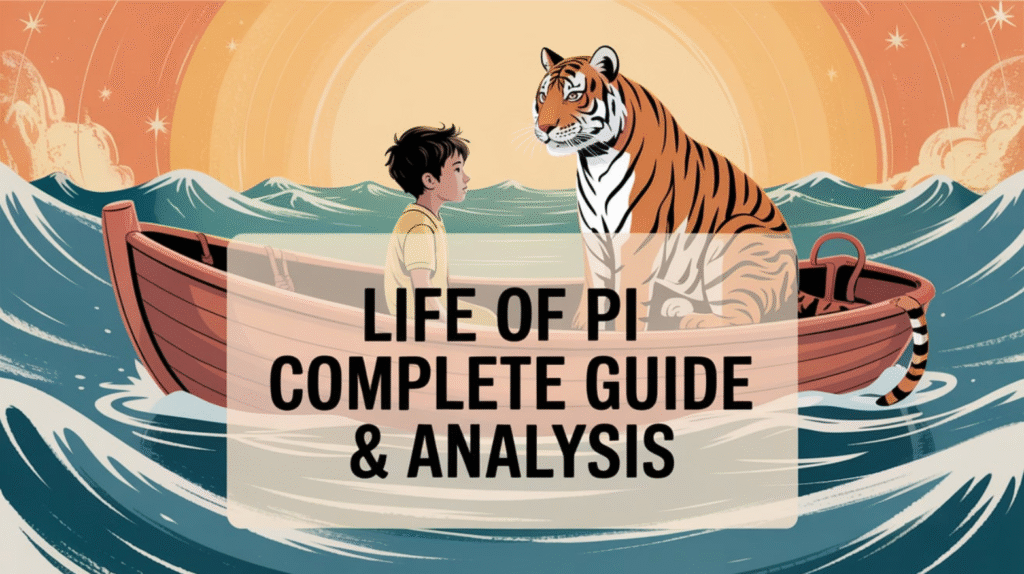Yann Martel’s Life of Pi (2001) blends survival adventure with spiritual parable. The novel follows Piscine Molitor “Pi” Patel as he endures 227 days adrift on the Pacific in a lifeboat, accompanied, perhaps, by a Bengal tiger named Richard Parker. Use the section links below (or simply scroll) for bite-sized, spoiler-safe overviews you can expand into full articles.

Themes & Motifs
Faith vs. reason, the fluidity of truth, and the will to survive dominate the text. Recurrent motifs—animal duality, orange hues, hunger/thirst cycles—reinforce Pi’s struggle to reconcile science with spirituality.
Character Journeys & Transformations
Pi evolves from curious zoo-keeper’s son to resourceful castaway and, ultimately, to an adult who embraces ambiguity. Richard Parker’s silent presence mirrors Pi’s own primal instincts.
Symbolism & Hidden Meanings
The lifeboat = the microcosm of belief systems; the tiger = uncontrolled id; the ocean’s shifting moods = divine mystery. Even the meerkat-laden algae island functions as a temptation allegory.
The Role of Setting as a “Character”
From Pondicherry Zoo’s ordered enclosures to the indifferent Pacific, each locale actively shapes the plot. The ocean’s isolation forces Pi’s psychological metamorphosis.
Narrative Style & Point-of-View Analysis
A frame narrative: an unnamed fictional author interviews adult Pi; Pi’s first-person account blurs fact and fiction. The layered POV invites the reader to become judge.
Memorable Quotes & Why They Matter
“A story with God is the better story.”
“I must say a word about fear. It is life’s only true opponent.”
These lines capture the novel’s philosophical core and Pi’s survival mantra.
Foreshadowing, Easter Eggs & Clues You Missed
Early hints—the sloth thesis, zoo-animal metaphors, and casual cannibalism references—prefigure later twists, signalling the reliability problem.
Unreliable Narrator—What You Can (and Can’t) Trust
Pi admits he chooses stories. Discrepancies between his oral tale and the “report” prompt readers to weigh evidence versus faith.
Structural Twists & Timeline Tricks
Part One (Pondicherry), Part Two (Pacific), Part Three (Mexico). The abrupt tonal switch between Parts Two and Three reframes everything preceding it.
Author’s Inspiration & Real-World Context
Martel credits Moacyr Scliar’s Max and the Cats as seed idea; months in India, religious texts, and shipwreck accounts inform the detail.
Top Fan Theories—and How Plausible They Are
Hallucination theory, dual-story allegory, and after-life limbo debates fuel forums. Each theory hinges on the final interrogation scene.
Comparative Reading—Books & Adaptations
Ang Lee’s 2012 film preserves visuals (bioluminescent whale, flying fish) but trims philosophical digressions. The final shot nudges viewers toward the “better story” reading.
Key Literary Devices and Why They Work
- Allegory makes spiritual themes accessible.
- Zoomorphism upends human–animal hierarchy.
- Intertextual epigraphs foreground the metafictional conceit.
Cultural & Historical Backdrop Explained
1970s India (Emergency era) and Pondicherry’s French colonial past colour Pi’s multicultural spiritual identity.
World-Building 101—Rules of the Universe
Martel grounds the fantastic with zoological facts: territory-marking, tiger psychology, solar-still operation—lending plausibility to surreal moments.
Tone, Atmosphere & Emotional Impact
Lyrical, contemplative, then visceral. Lulls of wonder (glow plankton) punctuate bursts of terror (hyena kill), sustaining narrative tension.
Book Club Discussion Questions
- Is faith stronger when facts are scarce?
- Which version of Pi’s story do you accept—and why?
- How does Martel use animals to critique human morality?
The Book’s Legacy and Influence
Winner of the 2002 Booker Prize; 15-million-plus copies sold; spurred a surge in “spiritual survival” narratives and cross-media adaptations (film, stage).
Deep Dive into Richard Parker’s Motivation
Beyond predator, the tiger embodies Pi’s suppressed ferocity and coping mechanism. His silent departure underscores the cost of survival.
FAQs—What Readers Most Want to Know
Was there really a tiger?
The text leaves it ambiguous—Martel invites readers to choose.
What’s the meaning of the algae island?
A seductive but ultimately deadly mirage—comfort that consumes faith if you linger.
Quick-Navigation Links
← Back to Books Hub • Jump to Themes | Characters | Symbolism | FAQ
